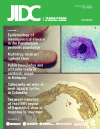Multidrug-resistant typhoid fever: a review
DOI:
https://doi.org/10.3855/jidc.1405Keywords:
multidrug resistant typhoid fever, Salmonella enterica serovar typhi, quinolone resistance, typhoid vaccine, typhoid fever, plasmid-mediated resistance, chromosomal-mediated resistance, Salmonella Typhi, public health educationAbstract
Introduction: Multidrug-resistant typhoid fever (MDRTF) is defined as typhoid fever caused by Salmonella enterica serovar Typhi strains (S. Typhi), which are resistant to the first-line recommended drugs for treatment such as chloramphenicol, ampicillin and trimethoprim-sulfamethoxazole. Since the mid-1980s, MDRTF has caused outbreaks in several countries in the developing world, resulting in increased morbidity and mortality, especially in affected children below five years of age and those who are malnourished.
Methodology: Two methods were used to gather the information presented in this article. First PubMed was searched for English language references to published relevant articles. Secondly, chapters on typhoid fever in standard textbooks of paediatric infectious diseases and preventive and social medicine were reviewed.
Results: Although there are no pathognomonic clinical features of MDRTF at the onset of the illness, high fever ( > 104°F), toxaemia, abdominal distension, abdominal tenderness, hepatomegaly and splenomegaly are often reported. The gold standard for the diagnosis of MDRTF is bacterial isolation of the organism in blood cultures. Ciprofloxacin and ceftriaxone are the drugs most commonly used for treatment of MDRTF and produce good clinical results.
Conclusion: MDRTF remains a major public health problem, particularly in developing countries. Mass immunization in endemic areas with either the oral live attenuated Typhi 21a or the injectable unconjugated Vi typhoid vaccine, rational use of antibiotics, improvement in public sanitation facilities, availability of clean drinking water, promotion of safe food handling practices and public health education are vital in the prevention of MDRTF.
Downloads
Published
How to Cite
Issue
Section
License
Authors who publish with this journal agree to the following terms:
- Authors retain copyright and grant the journal right of first publication with the work simultaneously licensed under a Creative Commons Attribution License that allows others to share the work with an acknowledgement of the work's authorship and initial publication in this journal.
- Authors are able to enter into separate, additional contractual arrangements for the non-exclusive distribution of the journal's published version of the work (e.g., post it to an institutional repository or publish it in a book), with an acknowledgement of its initial publication in this journal.
- Authors are permitted and encouraged to post their work online (e.g., in institutional repositories or on their website) prior to and during the submission process, as it can lead to productive exchanges, as well as earlier and greater citation of published work (See The Effect of Open Access).








